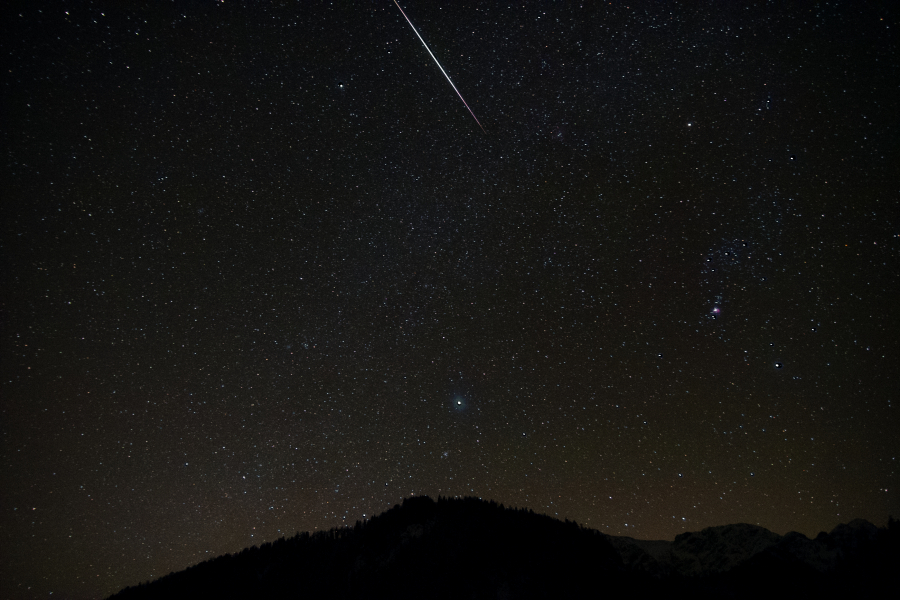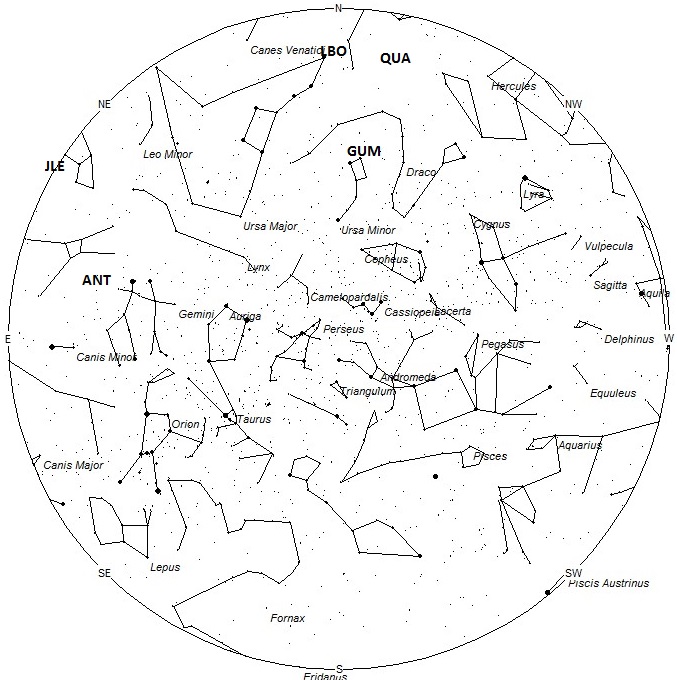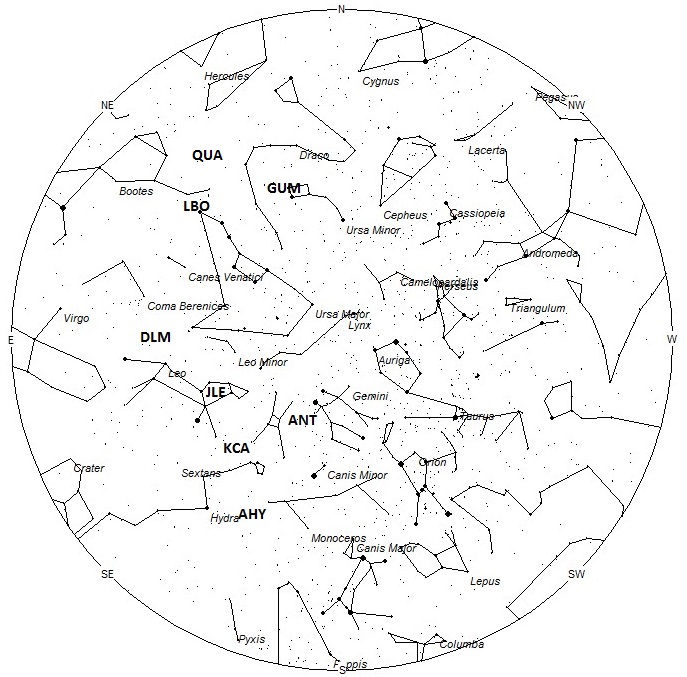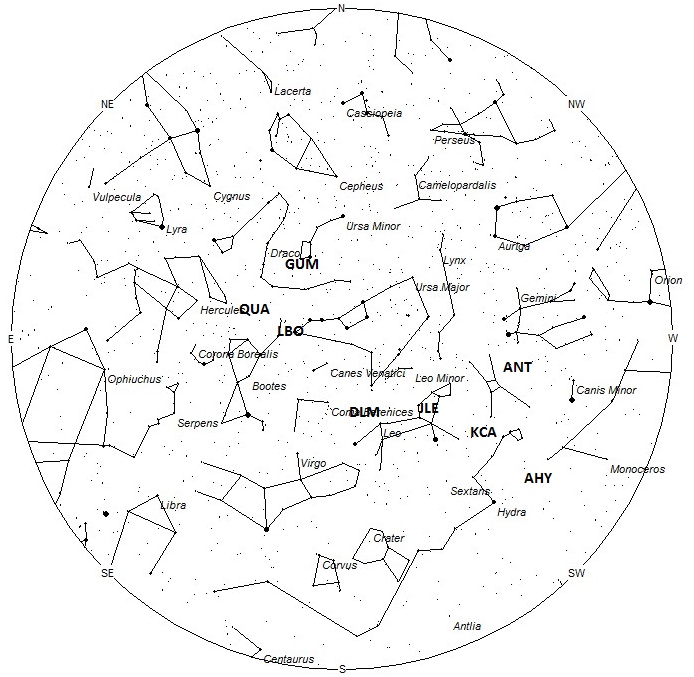
During this period the moon will reach its new phase on Saturday January 5th. At this time the moon will be located near the sun and will be invisible at night. As the week progresses the waxing crescent moon will enter the evening sky but will set long before the more active morning hours arrive. Hourly meteor rates for evening observers this week is near 3 as seen from mid-northern latitudes (45N) and 2 as seen from tropical southern locations (25S). For morning observers the estimated total hourly rates should be near 15 as seen from mid-northern latitudes and 12 from the southern tropics. The actual rates will also depend on factors such as personal light and motion perception, local weather conditions, alertness and experience in watching meteor activity. Note that the hourly rates listed below are estimates as viewed from dark sky sites away from urban light sources. Observers viewing from urban areas will see less activity as only the brighter meteors will be visible from such locations.
The radiant (the area of the sky where meteors appear to shoot from) positions and rates listed below are exact for Saturday night/Sunday morning January 5/6. These positions do not change greatly day to day so the listed coordinates may be used during this entire period. Most star atlases (available at science stores and planetariums) will provide maps with grid lines of the celestial coordinates so that you may find out exactly where these positions are located in the sky. A planisphere or computer planetarium program is also useful in showing the sky at any time of night on any date of the year. Activity from each radiant is best seen when it is positioned highest in the sky, either due north or south along the meridian, depending on your latitude. It must be remembered that meteor activity is rarely seen at the radiant position. Rather they shoot outwards from the radiant so it is best to center your field of view so that the radiant lies near the edge and not the center. Viewing there will allow you to easily trace the path of each meteor back to the radiant (if it is a shower member) or in another direction if it is a sporadic. Meteor activity is not seen from radiants that are located far below the horizon. The positions below are listed in a west to east manner in order of right ascension (celestial longitude). The positions listed first are located further west therefore are accessible earlier in the night while those listed further down the list rise later in the night.

Radiant Positions at 19:00 Local Standard Time
 Radiant Positions at 00:00 Local Standard Time
Radiant Positions at 00:00 Local Standard Time
Radiant Positions at 5:00 Local Standard Time
These sources of meteoric activity are expected to be active this week.
Now that the activity from particles produced by comet 2P/Encke have ceased encountering the Earth, the Taurid showers are over and we resume reporting activity from the Anthelion (ANT) radiant. This is not a true radiant but rather activity caused by the Earth’s motion through space. As the Earth revolves around the sun it encounters particles orbiting in a pro-grade motion that are approaching their perihelion point. They all appear to be radiating from an area near the opposition point of the sun, hence the name Anthelion. These were once recorded as separate showers throughout the year but it is now suggested to bin them into their category separate from true showers and sporadics. There are several lists that have the delta Cancrids currently active, but we include them with the Anthelions as the celestial positions overlap. This radiant is a very large oval some thirty degrees wide by fifteen degrees high. Activity from this radiant can appear from more than one constellation. The position listed here is for the center of the radiant which is currently located at 07:52 (118) +21. This position lies in eastern Gemini, 7 degrees south of the 1st magnitude star known as Pollux (beta Geminorum). Since the radiant is so large, Anthelion activity may also appear from Cancer as well as Gemini. This radiant is best placed near 01:00 local standard time (LST) when it lies on the meridian and is highest in the sky. Rates at this time should be near 2 per hour as seen from the northern hemisphere and 1 per hour as seen from south of the equator. With an entry velocity of 30 km/sec., the average Anthelion meteor would be of slow velocity.
The alpha Hydrids (AHY) were discovered by Dr. Peter Brown and are mentioned in his article “A meteoroid stream survey using the Canadian Meteor Orbit Radar”. This shower is active from December 17 through January 17 with maximum activity occurring on January 3rd. The radiant is currently located at 08:14 (130) -09. This position lies in southwestern Hydra, 10 degrees west of the 2nd magnitude star known as Alphard (alpha Hydrae). These meteors are best seen near 0200 LST when the radiant lies highest above the horizon. At 43 km/sec. the alpha Hydrids produce meteors of medium velocity. Expected rates this week are near 1 per hour no matter your location.
The kappa Cancrids (KCA) are not normally mentioned as a target for visual observers but during 2015 and 2016, activity has been noticed on video cameras that could be viewed by visual observers. These meteors are expected to be most active on January 10, between 3:00 and 4:00 Universal Time. This is during the morning hours for observers in Europe. At that time the radiant will be located in the western sky near the position of 09:12 (138) +09. This area of the sky lies approximately 5 degrees northeast of the “head” of Hydra. Nothing extraordinary is expected but any activity would be newsworthy. These meteors would most likely have a velocity of near 50 km/sec. and produce medium-fast meteors.
The last of the January Leonids (JLE) are expected this weekend. This shower is active from December 30 through January 7 with maximum activity occurring on January 3rd. The radiant is currently located at 10:03 (151) +23. This position lies in northwestern Leo, 2 degrees west of the 3rd magnitude star known as Adhafera (zeta Leonis). These meteors are best seen near 0300 LST when the radiant lies highest above the horizon. At 59 km/sec. the January Leonids produce meteors of swift velocity. Expected rates this weekend are less than 1 per hour no matter your location.
The December Leonis Minorids (DLM) are a shower of long duration active from December 6th through January 18th. Maximum occurs near December 21st when rates may reach 3 an hour. Current rates are likely around 1 per hour as seen from the northern hemisphere and less than 1 as seen from south of the equator. The radiant is currently located at 11:38 (175) +23. This position lies in eastern Leo, 8 degrees north of the 2nd magnitude star known as Denebola (beta Leonis). These meteors are best seen near 0400 LST when the radiant lies highest above the horizon. At 63 km/sec. the December Leonis Minorids produce mostly swift meteors.
The lambda Bootids (LBO) were discovered by Dr. Peter Brown and his team at the University of Western Ontario, London, Ontario, Canada. They were using radio means to discover new streams. These meteors are active from December 31 through January 17 with maximum activity occurring on the 16th. The radiant currently lies at 14:04 (211) +50. This position lies on the border of Bootes and Ursa Major, 2 degrees east of the 2nd magnitude star known as Alkaid (eta Ursae Majoris). Current rates are expected to be near 1 per hour as seen from the northern hemisphere. Rates would be less than 1 per hour for observers located in the southern hemisphere. At 41 km/sec. these meteors are of medium velocity.
The gamma Ursae Minorids (GUM) were also discovered by Dr. Peter Brown and associates. These meteors are active from January 09-20, with maximum occurring on the 18th. The radiant is currently located at 15:08 (227) +72, which places it southern Ursa Minor, just southwest of the 3rd magnitude star known as Pherkad (gamma Ursae Minoris). These meteors are best seen during the last few hours before dawn, when the radiant lies highest in a dark sky. Expected rates are less than 1 per hour during this period no matter your location. These meteors encounter the atmosphere at 30 km/sec., which would produce meteors of medium-slow velocity.
The Quadrantids (QUA) peaked on January 3/4 and now only a few remnants are left to be seen . The radiant is currently located at 15:24 (231) +49. This position lies in a blank area of northern Bootes, 10 degrees north of the 3rd magnitude star known as Nekkar (beta Bootis). Since we are well past maximum activity, current rates are less than 1 per hour. These meteors are best seen during the last hour before dawn when the radiant lies highest above the horizon in a dark sky. At 41 km/sec. the Quadrantids produce meteors of moderate velocity. These meteors are visible from the southern tropics but not seen from the deep southern hemisphere.
As seen from the mid-northern hemisphere (45N) one would expect to see approximately 10 sporadic meteors per hour during the last hour before dawn as seen from rural observing sites. Evening rates would be near 2 per hour. As seen from the tropical southern latitudes (25S), morning rates would be near 9 per hour as seen from rural observing sites and 2 per hour during the evening hours. Locations between these two extremes would see activity between the listed figures.
The list below offers the information from above in tabular form. Rates and positions are exact for Saturday night/Sunday morning except where noted in the shower descriptions.
| SHOWER | DATE OF MAXIMUM ACTIVITY | CELESTIAL POSITION | ENTRY VELOCITY | CULMINATION | HOURLY RATE | CLASS |
| RA (RA in Deg.) DEC | Km/Sec | Local Standard Time | North-South | |||
| Anthelion (ANT) | – | 07:52 (118) +21 | 30 | 01:00 | 3 – 2 | II |
| alpha Hydrids (AHY) | Jan 03 | 08:14 (130) -09 | 43 | 01:00 | 1 -1 | IV |
| kappa Cancrids (KCA) | Jan 10 | 09:12 (138) +09 | 50? | 0200 | ? | IV |
| January Leonids (JLE) | Jan 03 | 10:03 (151) +23 | 51 | 03:00 | <1 – <1 | IV |
| December Leonis Minorids (DLM) | Dec 21 | 11:38 (175) +23 | 63 | 04:00 | 1 – <1 | II |
| lambda Bootids (LBO) | Jan 16 | 14:04 (211) +50 | 41 | 07:00 | <1 – <1 | I |
| gamma Ursae Minorids (GUM) | Jan 18 | 15:08 (227) +72 | 30 | 08:00 | <1 – <1 | II |
| Quadrantids (QUA) | Jan 03 | 15:24 (231) +49 | 41 | 08:00 | <1 – <1 | I |




 You saw something bright and fast? Like a huge shooting star? Report it: it may be a fireball.
You saw something bright and fast? Like a huge shooting star? Report it: it may be a fireball.  You counted meteors last night? Share your results with us!
You counted meteors last night? Share your results with us!  You took a photo of a meteor or fireball? You have a screenshot of your cam? Share it with us!
You took a photo of a meteor or fireball? You have a screenshot of your cam? Share it with us!  You caught a meteor or fireball on video? Share your video with us!
You caught a meteor or fireball on video? Share your video with us!